

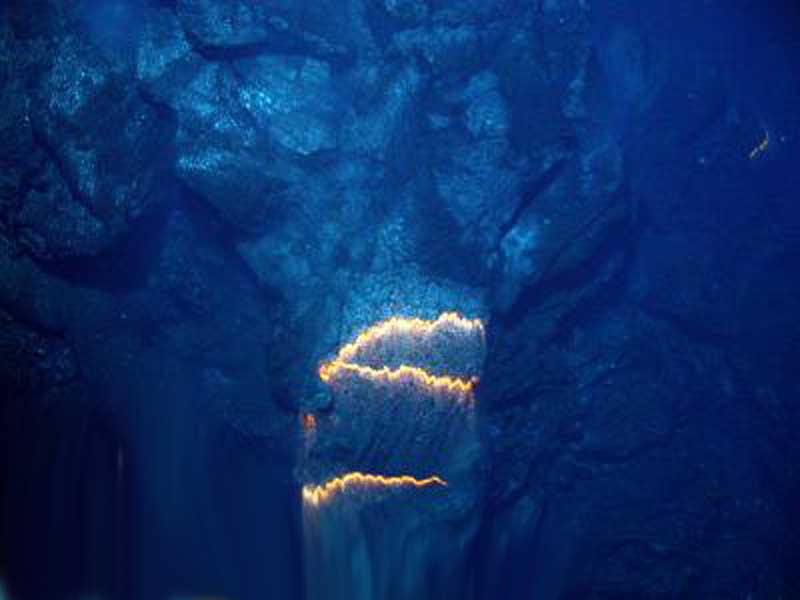
Bands of glowing magma from submarine volcano

Spreading ridges volcanoes map

Map of world's major seamounts
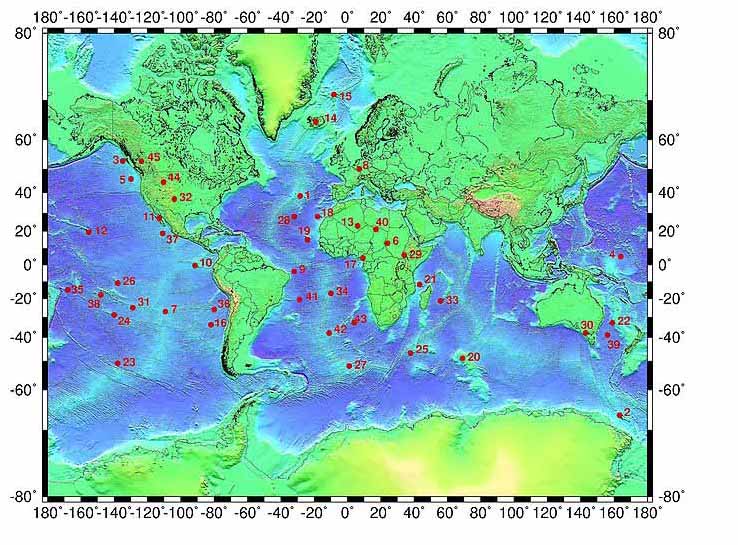
Map of world's major hotspots
Submarine volcanoes are underwater fissures in the Earth's surface from which magma can erupt. They are estimated to account for 75% of annual magma output. The vast majority are located near areas of tectonic plate movement, known as ocean ridges.
Although most are located in the depths of seas and oceans, some also exist in shallow water, which can spew material into the air during an eruption. Hydrothermal vents, sites of abundant biological activity, are commonly found near submarine volcanoes.
The presence of water can greatly alter the characteristics of a volcanic eruption and the explosions made by these. For instance, the increased thermal conductivity of water causes magma to cool and solidify much more quickly than in a terrestrial eruption, often turning it into a volcanic glass.
Below ocean depths of about 2200 meters where the pressure exceeds 218 atmospheres, the critical pressure of water, it can no longer boil; it becomes a supercritical fluid. Without boiling sounds, deep-sea volcanoes are difficult to detect at great distances using hydrophones.
The lava formed by submarine volcanoes is quite different from terrestrial lava. Upon contact with water, a solid crust forms around the lava. Advancing lava flows into this crust, forming what is known as pillow lava.
Scientists still have much to learn about the location and activity of underwater volcanoes. The Kolumbo underwater volcano in the Aegean Sea was discovered in 1650 when it burst from the sea and erupted, killing 70 people on the nearby island of Santorini.
More recently, NOAA's Office of Ocean Exploration has funded missions to explore submarine volcanoes. Most notably, these have been the Ring of Fire missions to the Mariana Arc in the Pacific Ocean. Using Remote Operated Vehicles, scientists studied underwater eruptions, ponds of molten sulfur, black smoker chimneys and even marine life adapted to this deep, hot environment.
Many submarine volcanoes are usually found as seamounts. These are typically formed from extinct volcanoes, that rise abruptly and are usually found rising from a seafloor of 1,000 - 4,000 meters depth. They are defined by oceanographers as independent features that rise to at least 1,000 meters above the seafloor. The peaks are often found hundreds to thousands of meters below the surface, and are therefore considered to be within the deep sea.
An estimated 30,000 seamounts occur across the globe, with only a few having been studied. However, some seamounts are also unusual. For example, while the summits of seamounts are normally hundreds of meters below sea level, the Bowie Seamount in Canada's Pacific waters rises from a depth of about 3,000 meters to within 24 meters of the sea surface. Submarine Volcanoes
Undersea Volcano Off The US West Coast Predicted To Erupt In 2025 Live Science - December 30, 2024

A submarine volcano near Oregon looks like it could erupt at any time, and scientists have stuck their necks out by predicting that the event will occur before the end of 2025. Forecasting volcanic eruptions with more than a few hours' notice is currently a huge challenge, yet researchers have identified an undersea volcano called Axial Seamount as the perfect place to start practicing. Located on the Juan de Fuca Ridge, some 480 kilometers (300 miles) off the US west coast, Axial is the most active submarine volcano in the northeast Pacific, erupting with sufficient regularity for scientists to try and study the patterns that precede these blow-outs.
'High-definition radar satellites have revealed more than 19,000 undersea volcanoes around our planet, providing scientists with the most comprehensive catalog of seamounts ever created Live Science - April 28, 2023
The new compendium could provide a better understanding of ocean currents, plate tectonics and climate change.
Scientists find strange underwater volcano that 'looks like a Bundt cake' Live Science - April 26, 2023
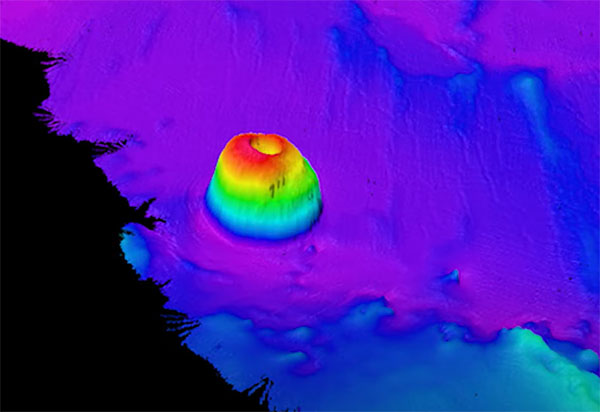
The Saildrone Surveyor mission discovered the unnamed, 3,200-foot-tall formation in February while mapping the seafloor off the coast of California. The unnamed, 3,200 foot (975 meter) tall formation falls just short of the required size for a seamount - at least 3,300 feet (1,000 m) above the surrounding seafloor, according to the National Oceanic and Atmospheric Administration (opens in new tab) (NOAA). Nonetheless, oceanographers have referred to the feature as such because, like other seamounts, it is an underwater mountain with steep sides rising from the seafloor and the remnant of an extinct volcano.
Underwater volcanoes: How ocean color changes can signal an imminent eruption PhysOrg - January 24, 2022

The scale of a recent volcano eruption took the people of Tonga by surprise. Scientists monitoring the submarine volcano, Hunga Tonga-Hunga Ha'apai, were likewise caught off-guard, failing to foresee an explosion which would unleash a Pacific-wide tsunami. Scientists estimate that the blast may have been the loudest terrestrial event since the eruption of Krakatoa in 1883, while an organization that monitors nuclear tests went so far as to declare it the biggest thing they have ever seen.
The volcano had been active a few times in recent years, with moderate eruptions that only amounted to local disturbance. The lack of warning for an event this large left many wondering if there might be other volcanoes beneath the ocean similarly primed to blow. To study volcanoes and interpret whether they're likely to erupt, scientists mount them with different kinds of measuring equipment. Seismometers help them detect small tremors caused by magma moving under the ground, while gas samplers and thermal cameras can be used to track changes in gas concentrations and temperature as magma ascends from the depths.
It's rarely acknowledged, however, that most volcanic activity on Earth occurs beneath the sea. Submarine volcanoes are pretty much ubiquitous in all of the world's major oceans and it's estimated that 75% of the Earth's magma output comes from mid-ocean ridges. To make things trickier, many known submarine volcanoes are found far from land, and being underwater prevents scientists from observing any changes by conventional means. So how do we monitor them? Scientists have managed to install equipment that detects tell-tale tremors on the sea bed before.

2022 Hunga Tonga Eruption and Tsunami Wikipedia
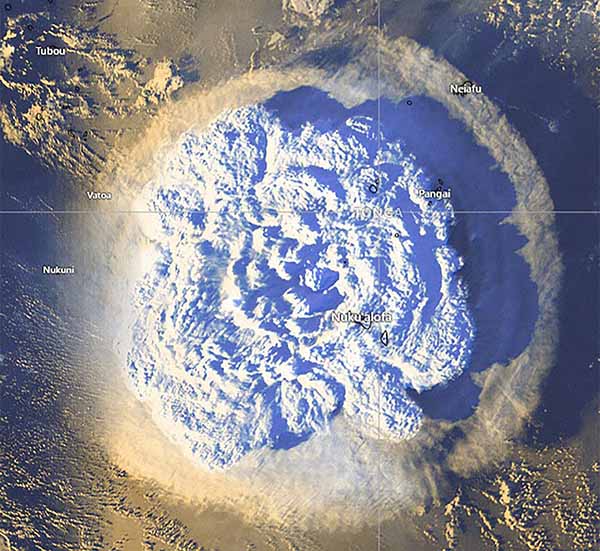
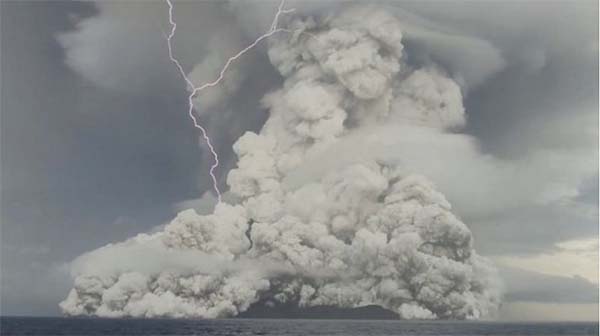
Tonga eruption equivalent to hundreds of Hiroshimas: NASA PhysOrg - January 24, 2022
Tonga: Survivor tells of sea escape from tsunami-struck island
Tonga volcano: Plume reached half-way to space
The Tonga Volcanic Eruption Was So Powerful It Sent Ripples Out Into Space
Tsunami Waves Over 4 Feet High Hit Pacific Coast after Major Eruption near Tonga
Waves between 1 and 4 feet were reported from California to Alaska Saturday after a tsunami advisory was issued because of a volcanic eruption in the South Pacific. The advisory was issued for Hawaii and the U.S. Pacific Coast including California, Oregon, Washington and parts of Alaska early Saturday morning after the undersea volcano erupted near the island nation of Tonga. A wave of 4.3 feet was reported in Port San Luis California, according to the National Weather Service. Large waves were also reported in King Cove, Alaska, La Push, Washington, and several other locations. Two people were transported to the hospital after being swept into the water Saturday afternoon at San Gregorio State Beach, according to local fire officials. One was taken by helicopter.
A toxic cloud spewing from an erupting volcano in Tonga could dump acid rainfall across the Pacific kingdom, potentially poisoning drinking water and damaging people's skin and eyes, emergency services have warned PhysOrg - December 22, 2021
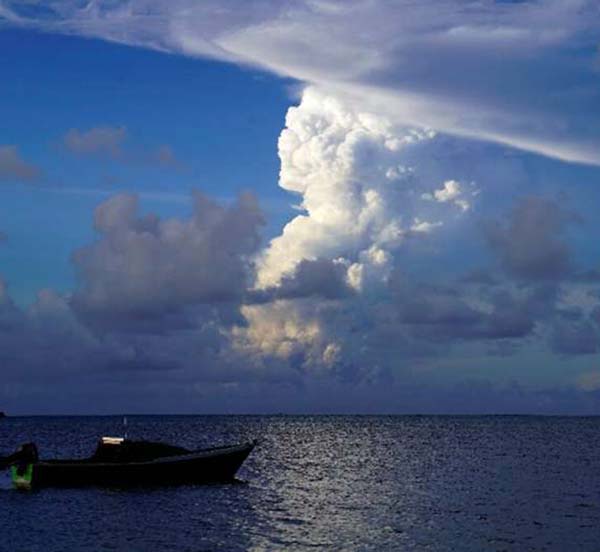
Police reported no injuries from the eruption but TGS said late Tuesday that the dust and gas could result in acidic rainfall if mixed with water in the atmosphere. It advised residents to remove guttering systems from their rainwater storage systems until the all-clear was given
Deep-sea volcanoes: Windows into the subsurface PhysOrg - November 30, 2020
Hydrothermally-active submarine volcanoes account for much of Earth's volcanism and are mineral-rich biological hotspots, yet very little is known about the dynamics of microbial diversity in these systems. This week in PNAS, Reysenbach and colleagues, show that at one such volcano, Brothers submarine arc volcano, NE of New Zealand, the geological history and subsurface hydrothermal fluid paths testify to the complexity of microbial composition on the seafloor, and also provide insights into how past and present subsurface processes could be imprinted in the microbial diversity.
How volcanoes explode in the deep sea PhysOrg - June 29, 2020
Most volcanic eruptions take place unseen at the bottom of the world's oceans. In recent years, oceanography has shown that this submarine volcanism not only deposits lava but also ejects large amounts of volcanic ash. There are around 1,900 active volcanoes on land or as islands. The number of submarine volcanoes is estimated to be much higher. Exact numbers are not known because the deep sea is largely unexplored. Accordingly, most submarine volcanic eruptions go unnoticed. Submarine volcanoes grow slowly upwards by recurring eruptions. When they reach the water surface, they become volcanic islands - like the active Stromboli near Sicily or some of the Canary Islands.
Underwater Volcano Creates Bubbles More Than a Quarter-Mile Across Live Science - October 17, 2019
In the early 20th century, sailors near Alaska reported seeing black bubbles seeming to boil out from the sea, each one the size of the dome of the capitol building in Washington, D.C. They weren't the only sailors who reported the bizarre phenomenon, and they weren't mistaken, except for one thing É the bubbles were much larger. When the mostly underwater Bogoslof volcano in the Aleutian Islands erupts, it produces giant bubbles that can reach up to 1,444 feet (440 meters) across, according to a new study. These bubbles are filled with volcanic gas, so when they burst they create volcanic clouds tens of thousands of feet in the sky, said lead author John Lyons, a research geophysicist at the Alaska Volcano Observatory of the U.S. Geological Survey. These volcanic clouds were captured in satellite images taken after the Bogoslof volcano last erupted in 2017 - but the bubbles themselves were never photographed.
A vast "raft" of volcanic rocks stretching is drifting through the Pacific Ocean. BBC - August 26, 2019
The sea of pumice - the size of 20,000 football fields - was first reported by Australian sailors earlier this month. Experts say the mass likely came from an underwater volcano near Tonga
Geologists Discover Largest Underwater Volcano, Explain Weird Hum Heard Around the World Live Science - May 23, 2019
A strange seismic event off the coast of Africa has led scientists to a mighty finding: the discovery of the largest underwater volcanic eruption ever recorded. The eruption also may explain a weird seismic event recorded in November 2018 just off the island of Mayotte, located between Madagascar and Mozambique in the Indian Ocean. Researchers described that event as a seismic hum that circled the world, but no one could figure out what sparked it. For starters, the hum rang at a single, ultralow frequency, which was strange because seismic waves usually rumble at many frequencies. Moreover, there were hardly any detectable "p-waves" or "s-waves," which usually accompany earthquakes. And, incredibly, the island of Mayotte moved a few inches south and east after the mysterious event.
Lost Chain of Underwater Volcanoes Is a Massive Whale Superhighway Live Science - October 10, 2018
Thanks to an especially slobbery "Looney Tune," the island of Tasmania is best-known for its eponymous devils. But the nearby Tasman Sea is no less rich in oddball biodiversity. Take, for example, the newest discovery reported by the Australian research vessel the Investigator. A team of seafaring scientists has uncovered an ancient highway of massive underwater volcanoes - and those submerged mountains (or "seamounts") are apparently brimming with whales, according to a news release from Australia's national science agency.
Weird Underwater Volcano Discovered Near Baja Live Science - December 14, 2012
Scientists have discovered one of the world's weirdest volcanoes on the seafloor near the tip of Baja, Mexico. The petite dome - about 165 feet tall (50 meters) and 4,000 feet long by 1,640 feet wide (1,200 m by 500 m) - lies along the Alarcon Rise, a submarine depression located on the seabed at the southern end of the Gulf of California. Tectonic forces are tearing the Earth's crust apart at the spreading center, creating a long rift where magma oozes toward the surface, cools and forms new ocean crust. Circling the planet like baseball seams, seafloor-spreading centers (also called midocean ridges) produce copious amounts of basalt, a low-silica content lava rock that makes up the ocean crust. (Silica, or silicon dioxide, is the main component of quartz, one of the most common minerals on Earth.)
Rise and fall of underwater volcano revealed BBC - May14, 2012
The violent rise and collapse of an underwater volcano in the Pacific Ocean is captured in startling clarity for the first time. Researchers studying the Monowai volcano, near Tonga, recorded huge changes in height in just two weeks.
Deep-sea volcanoes don't just produce lava flows, they also explode PhysOrg - March 28, 2011
Most deep-sea volcanoes produce effusive lava flows rather than explosive eruptions, both because the levels of magmatic gas tend to be low, and because the volcanoes are under a lot of pressure from the surrounding water.